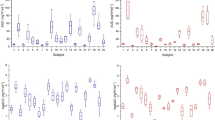Abstract
The epicutaneous histamine (EH) test is the current gold standard method for the clinical evaluation of allergic conditions. However, the EH method is limited in providing an objective and qualitative assessment of histamine pharmacodynamic response. The histamine iontophoresis with laser Doppler (HILD) monitoring method, an alternative method, allows a fixed dose of histamine to be delivered and provides an objective, continuous, and dynamic measurement of histamine epicutaneous response in children and adults. However, due to the high sampling frequency (up to 40 Hz), the output files are usually too cumbersome to be directly used for further analysis. In this study, we developed an averaging algorithm that efficiently reduces the HILD data in size. The reduced data was further analyzed and a population linked effect pharmacokinetic/pharmacodynamic (PK/PD) model was developed to describe the local histamine response. The model consisted of a one-compartment PK model and a direct-response fractional maximum effect (Emax) model. The parameter estimates were obtained as follows: absorption rate constant (ka), 0.094/min; absorption lag time (Tlag), 2.72 min; partitioning clearance from local depot to systemic circulation (CLpar), 0.0006 L/min; baseline effect (E0), 13.1 flux unit; Emax, 13.4; concentration at half maximum effect (EC50) 31.1 mg/L. Covariate analysis indicated that age and race had significant influence on Tlag and EC50, respectively.





Similar content being viewed by others
References
Simons FE, Simons KJ (2005) Levocetirizine: pharmacokinetics and pharmacodynamics in children age 6 to 11 years. J Allergy Clin Immunol 116(2):355–361. doi:10.1016/j.jaci.2005.04.010
Deschamps C, Dubruc C, Mentre F, Rosenzweig P (2000) Pharmacokinetic and pharmacodynamic modeling of mizolastine in healthy volunteers with an indirect response model. Clin Pharmacol Ther 68(6):647–657. doi:10.1067/mcp.2000.112341
Jones BL, Kearns G, Neville KA, Sherwin CM, Spigarelli MM, Leeder JS (2013) Variability of histamine pharmacodynamic response in children with allergic rhinitis. J Clin Pharmacol 53(7):731–737. doi:10.1002/jcph.93
Jones BL, Abdel-Rahman SM, Simon SD, Kearns GL, Neville KA (2009) Assessment of histamine pharmacodynamics by microvasculature response of histamine using histamine iontophoresis laser Doppler flowmetry. J Clin Pharmacol 49(5):600–605. doi:10.1177/0091270009332247
Upton G, Cook (1996) Understanding statistics. Oxford University Press, Oxford, p 55
Olsson P, Hammarlund A, Pipkorn U (1988) Wheal-and-flare reactions induced by allergen and histamine: evaluation of blood flow with laser Doppler flowmetry. J Allergy Clin Immunol 82(2):291–296
Kong AN, Ludwig EA, Slaughter RL, DiStefano PM, DeMasi J, Middleton E Jr, Jusko WJ (1989) Pharmacokinetics and pharmacodynamic modeling of direct suppression effects of methylprednisolone on serum cortisol and blood histamine in human subjects. Clin Pharmacol Ther 46(6):616–628
Abelo A, Holstein B, Eriksson UG, Gabrielsson J, Karlsson MO (2002) Gastric acid secretion in the dog: a mechanism-based pharmacodynamic model for histamine stimulation and irreversible inhibition by omeprazole. J Pharmacokinet Pharmacodyn 29(4):365–382
Leroy T, Tasset C, Valentin B, Van Neste D (1998) Comparison of the effects of cetirizine and ebastine on the skin response to histamine iontophoresis monitored with laser Doppler flowmetry. Dermatology 197(2):146–151
Ahluwalia P, McGill JI, Church MK (2001) Nedocromil sodium inhibits histamine-induced itch and flare in human skin. Br J Pharmacol 132(3):613–616. doi:10.1038/sj.bjp.0703852
Sheiner LB, Stanski DR, Vozeh S, Miller RD, Ham J (1979) Simultaneous modeling of pharmacokinetics and pharmacodynamics: application to d-tubocurarine. Clin Pharmacol Ther 25(3):358–371
Casti JL (1994) Simple and complex models in science. SFI working paper (1996-06-034)
Kubota K, Maibach HI (1992) A compartment model for percutaneous absorption: compatibility of lag time and steady-state flux with diffusion model. J Pharm Sci 81(9):863–865
Zahouani H, Pailler-Mattei C, Sohm B, Vargiolu R, Cenizo V, Debret R (2009) Characterization of the mechanical properties of a dermal equivalent compared with human skin in vivo by indentation and static friction tests. Skin Res Technol 15(1):68–76. doi:10.1111/j.1600-0846.2008.00329.x
Diridollou S, Berson M, Vabre V, Black D, Karlsson B, Auriol F, Gregoire JM, Yvon C, Vaillant L, Gall Y, Patat F (1998) An in vivo method for measuring the mechanical properties of the skin using ultrasound. Ultrasound Med Biol 24(2):215–224
Middleton M, Sarno M, Agarwala SS, Glaspy J, Laurent A, McMasters K, Naredi P, O’Day S, Whitman E, Danson S, Cosford R, Gehlsen K (2002) Pharmacokinetics of histamine dihydrochloride in healthy volunteers and cancer patients: implications for combined immunotherapy with interleukin-2. J Clin Pharmacol 42(7):774–781
Li J, Huang X, Wang Q, Jing S, Jiang H, Wei Z, Zang Y, Liu Y, Zhao L, Fang Y, Feng W (2015) Pharmacokinetic properties and safety profile of histamine dihydrochloride injection in Chinese healthy volunteers: a phase I, single-center, open-label, randomized study. Clin Ther 37(10):2352–2364. doi:10.1016/j.clinthera.2015.07.017
Eun HC (1995) Evaluation of skin blood flow by laser Doppler flowmetry. Clin Dermatol 13(4):337–347
Anvari S, Vyhlidal CA, Dai H, Jones BL (2015) Genetic variation along the histamine pathway in children with allergic versus nonallergic asthma. Am J Respir Cell Mol Biol 53(6):802–809. doi:10.1165/rcmb.2014-0493OC
Acknowledgments
Grant funding provided by the National Heart, Lung, and Blood Institute Grant #1K23HL105783 (PI: B.Jones).
Author information
Authors and Affiliations
Corresponding author
Ethics declarations
Disclosure
None.
Electronic supplementary material
Below is the link to the electronic supplementary material.
Rights and permissions
About this article
Cite this article
Liu, X., Jones, B.L., Roberts, J.K. et al. Population pharmacokinetic/pharmacodynamic modeling of histamine response measured by histamine iontophoresis laser Doppler. J Pharmacokinet Pharmacodyn 43, 385–393 (2016). https://doi.org/10.1007/s10928-016-9478-9
Received:
Accepted:
Published:
Issue Date:
DOI: https://doi.org/10.1007/s10928-016-9478-9




